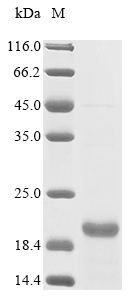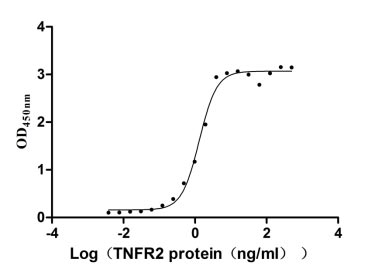Recombinant Mouse Oxytocin-neurophysin 1 (Oxt), partial
-
中文名称:小鼠Oxt重组蛋白
-
货号:CSB-EP017315MO
-
规格:¥2328
-
图片:
-
其他:
产品详情
-
纯度:Greater than 85% as determined by SDS-PAGE.
-
基因名:
-
Uniprot No.:
-
别名:Oxt; Oxytocin-neurophysin 1; OT-NPI) [Cleaved into: Oxytocin; Ocytocin); Neurophysin 1]
-
种属:Mus musculus(Mouse)
-
蛋白长度:Partial
-
来源:E.coli
-
分子量:17.1 kDa
-
表达区域:32-125aa
-
氨基酸序列AVLDLDMRKCLPCGPGGKGRCFGPSICCADELGCFVGTAEALRCQEENYLPSPCQSGQKPCGSGGRCAATGICCSPDGCRTDPACDPESAFSER
Note: The complete sequence including tag sequence, target protein sequence and linker sequence could be provided upon request. -
蛋白标签:N-terminal 10xHis-tagged and C-terminal Myc-tagged
-
产品提供形式:Liquid or Lyophilized powder
Note: We will preferentially ship the format that we have in stock, however, if you have any special requirement for the format, please remark your requirement when placing the order, we will prepare according to your demand. -
缓冲液:Tris-based buffer,50% glycerol
-
储存条件:Store at -20°C/-80°C upon receipt, aliquoting is necessary for mutiple use. Avoid repeated freeze-thaw cycles.
-
保质期:The shelf life is related to many factors, storage state, buffer ingredients, storage temperature and the stability of the protein itself.
Generally, the shelf life of liquid form is 6 months at -20°C/-80°C. The shelf life of lyophilized form is 12 months at -20°C/-80°C. -
货期:Basically, we can dispatch the products out in 1-3 working days after receiving your orders. Delivery time may differ from different purchasing way or location, please kindly consult your local distributors for specific delivery time.Note: All of our proteins are default shipped with normal blue ice packs, if you request to ship with dry ice, please communicate with us in advance and extra fees will be charged.
-
注意事项:Repeated freezing and thawing is not recommended. Store working aliquots at 4°C for up to one week.
-
Datasheet & COA:Please contact us to get it.
相关产品
靶点详情
-
功能:Neurophysin 1 specifically binds oxytocin.; Oxytocin causes contraction of the smooth muscle of the uterus and of the mammary gland. Acts by binding to oxytocin receptor (OXTR).
-
基因功能参考文献:
- The abnormal social behaviors of Dio3-/- mice were associated with sexually dimorphic alterations in the physiology of oxytocin (OXT) and arginine vasopressin (AVP), 2 neuropeptides with important roles in determining social interactions. PMID: 28715127
- Data indicate that oxytocin participates in the spine remodeling, synaptic refinement, and social stimuli-dependent plasticity in the posterodorsal medial amygdala of male mice. PMID: 28889007
- Activation of the oxytocin receptor in brain regions facilitates social defeat posture. PMID: 29186377
- the absence of OT leads to significant changes in the expression of the studied genes (OTR, ERalpha, ERbeta, V1aR), and these changes may contribute to the decreased sexual behavior observed in OT gene knockout females. PMID: 27558735
- These results reveal that Oxt protects pancreatic beta cells against death caused by metabolic stress, and Oxt signaling may be a potential therapeutic target. PMID: 27143105
- CA3 pyramidal cells in the adult mouse hippocampus express OXT receptors and receive inputs from hypothalamic OXT neurons. PMID: 28912554
- These results identify G9a-induced histone methylation at the OXT and AVP promoters in the Basolateral Amygdala as a mechanism for mediating stress-induced lasting behavioral depression and its reversal by exercise. PMID: 25863961
- Data indicate that oxytocin is an important synaptic modulator in the posterodorsal medial amygdala, a finding that is likely involved with the display of the female sexual behavior. PMID: 26163772
- OXT was up-regulated in both hypothalamic magnocellular neurosecretory cells and parvocellular cells by chronic inflammation, and also that OXT in the PVN-spinal pathway may be involved in sensory modulation PMID: 25943916
- role for a neuronal population in the control of maternal care and oxytocin secretion; and evidence for a causal relationship between sexual dimorphism in the adult brain and sex differences in parental behaviour PMID: 26375004
- Oxtr signaling is crucial for entrainment of odor to social cues but is dispensable for entrainment to nonsocial cues. Oxt conveys saliency of social stimuli to sensory representations in the piriform cortex during odor-driven social learning. PMID: 26139372
- Oxytocin is is required for proper muscle tissue regeneration and homeostasis, and that plasma levels of oxytocin decline with age. Genetic lack of oxytocin does not cause a developmental defect in muscle but instead leads to premature sarcopenia. PMID: 24915299
- results describe fundamental synaptic mechanisms by which oxytocin increases the salience of acoustic social stimuli; furthermore, oxytocin-induced plasticity provides a biological basis for lateralization of auditory cortical processing PMID: 25874674
- Results show that OT inhibits appetite for carbohydrates; sucrose consumption considerably enhances OT gene expression and is particularly sensitive to OT receptor blockade PMID: 24893201
- Data suggest that oxytocin plays a crucial role in the sexual behavior display, number of released oocytes and density of dendritic spines in the MePD of female mice without affecting AVP plasma concentration PMID: 23906766
- lactic acid microbes accelerate wound healing via the neuropeptide hormone oxytocin PMID: 24205344
- CD38 in the nucleus accumbens and oxytocin are critical in paternal behavior. PMID: 24059452
- A new form of plasticity is identified in neonatal mice, when early sensory experience cross-modally regulates development of all sensory cortices via oxytocin signaling. PMID: 24464043
- the rewarding properties of social interaction in mice require the coordinated activity of oxytocin and 5-HT in the nucleus accumbens--with implications for understanding the pathogenesis of social dysfunction in neuropsychiatric disorders like autism PMID: 24025838
- data suggest that OT modulates social investigation behavior and the aggressiveness of male mice. T PMID: 23376700
- Oxytocin pathways may not be essential for regulating voluntary sodium ingestion. PMID: 22784207
- medial amygdala likely modulates hostile aggressive behavior associated with immediate early gene expression in OXT and vasopressin neurons PMID: 23403283
- these results support the hypothesis that the expression of the mouse oxytocin receptor gene is epigenetically regulated by DNA methylation of its promoter. PMID: 23441222
- We conclude that Maged1 is required for oxytocin processing or stability. A decrease in mature OT levels in Maged1 mutants affects social interactions and possibly other behavioral processes PMID: 22865874
- OT release in bone marrow by a rising estrogen concentration may facilitate rapid skeletal recovery during the latter phases of lactation. PMID: 22761429
- We consider hypotheses of the roles played by central and systemic OT release as well as their control and modulation in the female in mating and pregnancy--REVIEW PMID: 22107910
- we describe data detailing the molecular mechanism of CD38-dependent OXT secretion in CD38 knockout mice--REVIEW PMID: 22227279
- results support the idea that variation in ovarian hormones could be related to individual differences in social recognition, at least partly through modulation of the OT and/or AVP systems, particularly in the DS, LA and MPOA. PMID: 22079582
- The data suggested that vasopressin or oxytocin exert a minimal effect on most GABA neurons in the lateral hypothalamus but exert a robust excitatory effect on presumptive GABA cells that contain melanin-concentrating hormone. PMID: 22262306
- there is a local feed-forward loop in bone marrow through which the OT so produced from osteoblasts in response to estrogen acts upon its receptor to exert a potent anabolic action. PMID: 21741363
- Oxytocin plays a pivotal role in mediating the adaptation mechanism following chronic homotypic stress in mice. PMID: 21439349
- Fto, a proposed transcription co-factor, influences expression of the gene encoding a satiety mediator, oxytocin. PMID: 21514276
- Recently a new tool has been created that has furthered our understanding of oxytocin's role in behavior: transgenic mice that lack either the ability to synthesize oxytocin or the oxytocin receptor itself--REVIEW PMID: 20732312
- global reduction in FGF8 signaling leads to an overall reduction of mature OT and oxyphysin prohormone levels that may have resulted from defects in multiple stages of the hormone-synthesis pathway PMID: 21046478
- central oxytocin plays a pivotal role in mediating the adaptation mechanism following repeated restraint stress in mice PMID: 20969650
- Oxytocin acts as a carbohydrate-specific inhibitor of feeding. PMID: 20685878
- OXT elicits Ca2+ signals via OXTR in murine taste buds PMID: 20700536
- Data show that EBs expressed Oct-4, OTR, OT, and DAZL. PMID: 19695304
- The upregulation of central oxytocin expression is involved in mediating the adaptation mechanism following chronic repeated stress in mice. PMID: 19889866
- oxytocin mediates stress-induced analgesia PMID: 11956346
- The OT/OTR system plays an important role in cardiogenesis by promoting cardiomyocyte differentiation. PMID: 12093924
- Results suggest that estrogen receptor-beta activation may play a critical role in estrogenic regulation of oxytocin and arginine vasopressin gene expression in the paraventricular nucleus. PMID: 12531518
- OT is 1)involved in tonic blood pressure maintenance; 2)extends the functional range of arterial baroreceptor reflex; 3)reduces the sympathetic reserve PMID: 12531722
- required for mammalian social recognition, through which an individual learns to recognize other individuals PMID: 12730370
- that OT pathways play a role in modulating anxiety in female mice of the C57BL/6 background, and the effect is mediated by the OT receptor. PMID: 12746288
- oestrogen-dependent regulation of oxytocin and vasopressin synthesis in the paraventricular hypothalamic nucleus is mediated by ERbeta. PMID: 12834440
- Blood oxytocin concentrations on d 9 postpartum were also lower in Usf2-/- mice than Usf2+/+ mice PMID: 12907752
- Regulatory element in the intergenic region of the oxytocin gene controls hypothalamus-specific expression. PMID: 12944509
- Oxytocin plays a role in the regulation of blood pressure and salt appetite. PMID: 12953013
- OT signaling pathways are unnecessary for the anorexigenic effects of systemically administered CCK and d-fenfluramine in C57BL/6 mice. PMID: 14557235
显示更多
收起更多
-
蛋白家族:Vasopressin/oxytocin family
-
数据库链接:
KEGG: mmu:18429
STRING: 10090.ENSMUSP00000028764
UniGene: Mm.16745
Most popular with customers
-
Recombinant Human Tumor necrosis factor receptor superfamily member 1B (TNFRSF1B), partial (Active)
Express system: Mammalian cell
Species: Homo sapiens (Human)
-
Recombinant Human Intestinal-type alkaline phosphatase (ALPI) (Active)
Express system: Mammalian cell
Species: Homo sapiens (Human)
-
Recombinant Human Complement component C1q receptor (CD93), partial (Active)
Express system: Mammalian cell
Species: Homo sapiens (Human)
-
Recombinant Macaca fascicularis CD93 molecule (CD93), partial (Active)
Express system: Mammalian cell
Species: Macaca fascicularis (Crab-eating macaque) (Cynomolgus monkey)
-
Recombinant Human Glucagon-like peptide 1 receptor (GLP1R), partial (Active)
Express system: Mammalian cell
Species: Homo sapiens (Human)
-
Recombinant Human Dickkopf-related protein 1 (DKK1) (Active)
Express system: Mammalian cell
Species: Homo sapiens (Human)
-
Recombinant Human Desmoglein-3 (DSG3), partial (Active)
Express system: Baculovirus
Species: Homo sapiens (Human)
-
Recombinant Human Cell adhesion molecule 1 (CADM1), partial (Active)
Express system: Mammalian cell
Species: Homo sapiens (Human)








-AC1.jpg)












